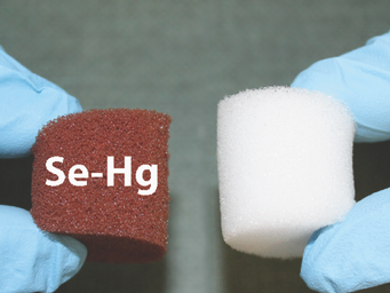Mercury is very toxic and can cause long-term health damage. Removing it from water is an important challenge. Even with pretreated waters and reduced flow rates, commercially available carbon-based adsorbents do not achieve final concentrations below 100 ng L–1. Selenium is an attractive candidate for new adsorbents because of its extremely high binding constant (1022) to Hg. To fully exploit this strong interaction for Hg sequestration, stable Se nanomaterials with high surface-to-volume ratios are needed.
Abdennour Abbas, University of Minnesota, Twin Cities, USA, and colleagues have developed a nanoselenium-polyurethane composite sponge (pictured) with outstanding Hg adsorption properties. Commercially available polyurethane (PU) sponges were soaked in selenous acid and dried to impregnate the material with Se. A chemical reduction step in hydroquinone solution led to the growth of Se nanostructures both on the surface and in the bulk of the PU sponge.
The material shows adsorption kinetics and a distribution coefficient two orders of magnitude higher than state-of-the-art mercury adsorbents. As a result, mercury contaminations are removed from tap, lake, and industrial water to below detectable limits (< 0.2 ng L–1) within between a few seconds and five minutes. The performance of the materials is independent of pH, and the sponge satisfies the requirements for disposal on a landfill after use.
- A Nanoselenium Sponge for Instantaneous Mercury Removal to Undetectable Levels,
Snober Ahmed, John Brockgreitens, Ke Xu, Abdennour Abbas,
Adv. Funct. Mater. 2017.
DOI: 10.1002/adfm.201606572




